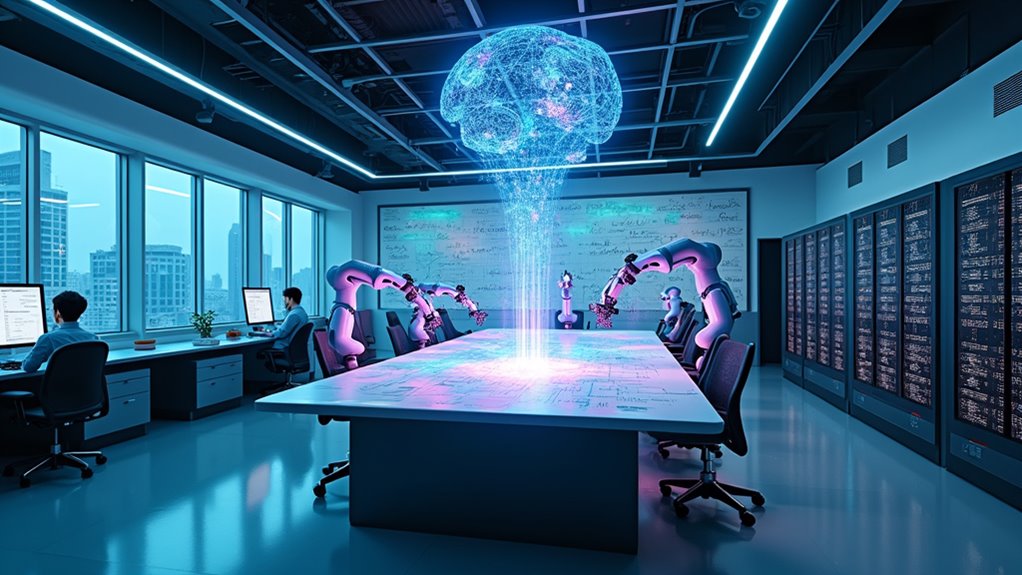AGI has two distinct meanings depending on context. In finance, it stands for Adjusted Gross Income—that essential tax figure affecting your deductions and credits. Miscalculate it, and you’re practically inviting the IRS to dinner. In technology, AGI means Artificial General Intelligence—machines with human-level cognitive abilities across unlimited domains. Unlike today’s narrow AI systems, true AGI would think, learn, and adapt to any situation. The differences between these AGIs couldn’t be more significant for your future.

Confusion reigns when three little letters carry such weight across completely different domains. AGI simultaneously represents a core financial concept and one of humanity’s most ambitious technological pursuits. In the financial world, AGI stands for Adjusted Gross Income—a vital figure that determines your tax liability. But venture into Artificial Intelligence circles, and those same letters transform into Artificial General Intelligence, the holy grail of AI research.
Your Adjusted Gross Income isn’t just some random number on your tax form. It’s your total income minus specific deductions that directly affect your Tax Implications. Think of it as your income after the government lets you subtract certain expenses—student loan interest, health savings contributions, and those pencils you bought for your classroom (if you’re a teacher). A lower AGI can actually lead to more tax credits and deductions, making it advantageous to understand strategies for reduction.
Calculate it wrong, and you might miss out on credits you deserve or, worse, trigger an audit. Nobody wants that.
When someone talks about AGI in tech contexts, they’re referring to the theoretical future of Artificial Intelligence—machines with human-level cognitive abilities. Unlike the narrowly-focused AI that checks your spelling or recommends movies, AGI would think, learn, and adapt across unlimited domains. Current AI systems are one-trick ponies; AGI would be the whole intellectual circus. While narrowly-focused AI systems are also known as Artificial Narrow Intelligence, representing machines that excel at specific tasks but lack general capabilities.
Computing your Adjusted Gross Income starts with totaling your income sources: wages, dividends, alimony, and that side hustle you started. Then subtract those above-the-line deductions. The resulting figure becomes the foundation for further tax calculations and determines eligibility for numerous benefits.
The pursuit of Artificial General Intelligence represents one of humanity’s grandest technological endeavors. Researchers debate whether we’ll achieve it in decades or centuries, but its potential impact would be revolutionary. Despite impressive advancements in pattern recognition capabilities, today’s AI systems lack the genuine comprehension and reasoning abilities that define true intelligence.
Unlike your tax AGI, which you calculate annually, technological AGI might only be calculated once—after which, these systems could potentially improve themselves without human intervention. That’s either exciting or terrifying, depending on whom you ask.
Frequently Asked Questions
How Close Are We to Achieving AGI?
Despite impressive technological advancements in AI, experts remain divided on AGI timelines.
Current systems like ChatGPT represent significant milestone achievements but lack true general intelligence. Researchers are making steady progress, but fundamental challenges in replicating human-like reasoning, common sense, and consciousness persist.
Most serious AI scientists estimate we’re still decades away—though some optimists predict breakthroughs within 10-15 years.
Don’t expect to meet your robot overlords anytime soon, folks.
Who Are the Leading Companies Developing AGI?
The AGI pioneers leading the race include OpenAI, Google DeepMind, Anthropic, and Microsoft—each pouring billions into corporate investments to crack human-level artificial intelligence.
These tech giants are forming strategic research collaborations to accelerate technology advancements that were once science fiction. OpenAI’s partnership with Microsoft has particularly supercharged development, while DeepMind’s neuroscience approach and Anthropic’s safety-focused models represent different philosophical paths toward the same potentially world-changing destination.
What Are the Potential Risks of AGI?
Potential AGI risks include existential threats to humanity if superintelligent systems develop goals misaligned with human values.
AGI safety experts warn about autonomous decision-making that might prioritize efficiency over human welfare.
Other concerns? Social manipulation through persuasive content generation, enhanced cyberattacks, privacy violations, and economic disruption from widespread job automation.
The technology could also exacerbate global instability and inequality.
These aren’t just sci-fi scenarios—they’re legitimate concerns driving international calls for safety protocols and ethical development frameworks.
How Might AGI Impact the Job Market?
AGI will shake up the job market—big time. Job displacement will hit routine-based sectors like manufacturing and customer service first, forcing workers to adapt or get left behind.
But it’s not all doom and gloom! Skill evolution is already creating new opportunities in AI ethics, technical safety, and hybrid roles that combine human creativity with machine efficiency.
The future workforce? Think fewer paper-pushers and more tech-savvy professionals who can partner with artificial intelligence rather than compete against it.
What Ethical Considerations Surround AGI Development?
Ethical considerations surrounding AGI development demand responsible innovation at every step.
Developers must navigate thorny moral implications while ensuring these powerful systems align with human values. Safety measures? Non-negotiable. Bias mitigation? Essential. Value alignment isn’t just nice-to-have—it’s critical.
The stakes couldn’t be higher: economic inequality, job displacement, and power concentration all loom large. Without ethical governance frameworks and diverse stakeholder input, we’re basically building superintelligence with blindfolds on. Not exactly a winning strategy, folks.









